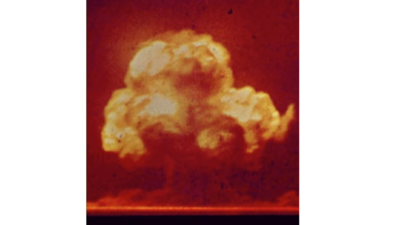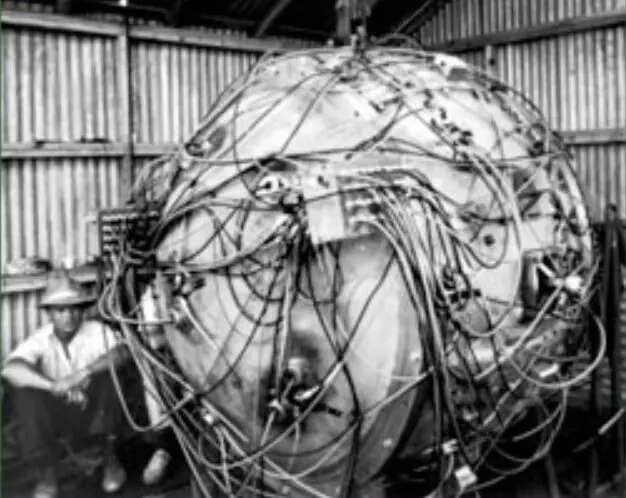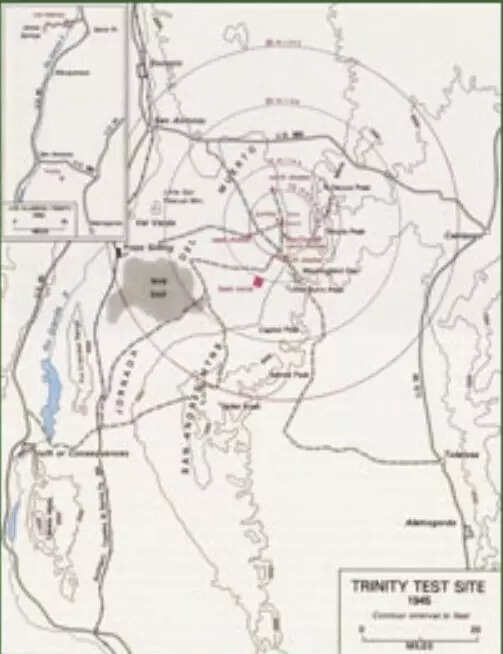Nuclear Shadows: The Explosion That Started It All | - The Times of India

Nuclear Shadows: The Explosion that started it all (Pic Credit: OSTI-US Dept Of Energy)
In the pre-dawn dark of July 16, 1945, a searing flash lit up the New Mexico desert. A shockwave followed, rippling outward across the silent plains. This was
Trinity
— the world’s first nuclear explosion, marking the moment humankind crossed into the atomic age.Part of The
Manhattan Project
led by J Robert Oppenheimer, Trinity was a codename
Oppenheimer
chose inspired by John Donne’s Holy Sonnets. At 5:29:45 am local time, Trinity’s atomic device, codenamed “The Gadget”, exploded with terrifying precision. As per US Energy Department archives, observers saw the desert floor turn to glass and a mushroom cloud soar 12km into the atmosphere. “The site chosen was a remote corner on the Alamogordo Bombing Range known as the ‘Jornada del Muerto’, or ‘Journey of Death’, 210 miles south of Los Alamos… The Trinity test could be seen as far away as 250 miles and the noise heard for fifty miles,” the archives read.Only minutes after the explosion, Leslie
Groves
, Brigadier-General US Army Corps of Engineers who directed The Manhattan Project, and Oppenheimer began composing their report for Secretary of War Henry Stimson and President Harry S
Truman
.
“There was a sense of urgency surrounding this notification, as Truman had already arrived at Potsdam (outside of Berlin) to confer with other Allied leaders on the conclusion of the war with Japan. Now that the potential of the bomb had been proven, the calculations behind the Potsdam negotiations were dramatically different,” the archives read.On July 16, Stimson received a telegram from his special assistant on atomic issues in Washington, George L Harrison. It read: “Operated on this morning. Diagnosis not yet complete but results seem satisfactory and already exceed expectations. Local press release necessary as interest extends great distance. Dr Groves pleased. He returns tomorrow. I will keep you posted. (sic).”Less than a month later, atomic bombs dropped on Hiroshima and Nagasaki ended World War II — but opened a permanent chapter of dread.
In the run-up to Trinity test, on July 12, the plutonium core was transported to the test site in an army sedan. Just after midnight — at 12:01 am on Friday the 13th — the non-nuclear components followed. That day, final assembly of the device, nicknamed the “Gadget”, was carried out inside the McDonald Ranch house. By 5 pm on July 15, it had been assembled and raised atop a 100-foot steel tower.Rain poured as key figures, including Groves, arrived at the site. At one of the control bunkers, Groves and Oppenheimer discussed worsening weather and its threat to the scheduled 4 am test.

Unidentified man with gadget shortly before the test. (Pic credit: OSTI-US Dept Of Energy
To lighten the mood, Enrico Fermi, another member of The Manhattan Project offered wagers on whether the bomb might ignite the atmosphere. Oppenheimer bet $10 against another Manhattan Project member George Kistiakowsky’s monthly salary that it wouldn’t work at all.At 3.30am, the test was delayed to 5.30 am. The rain stopped at 4 am. By 5 am, Kistiakowsky’s team had armed the device. Observers in shelters heard the countdown via loudspeakers; those at base camp listened on radio.

Birth of bomb
The Trinity test was the most powerful man-made explosion in history at the time — and also the riskiest moment of the entire Manhattan Project. Aware of the dangers, planners chose a remote desert area 20 miles from the nearest inhabited area.“Even so, the threat was significant,” the archives read. “The explosion could exceed predictions, putting both personnel and surrounding communities at risk. Scientists were moved nearly six miles away behind barricades. Groves and Oppenheimer observed from separate sites — an intentional move in case one didn’t survive.”

Map of trinity test site (Pic credit: OSTI-US Dept Of Energy)
Though fears that the blast might ignite the atmosphere were ruled out, radiation remained a primary concern. The detonation sent a 25,000-foot-high mushroom cloud across the region. Though fallout near ground zero was limited, radioactive debris drifted north-east. Army surveys had missed several ranch families, who were later exposed to significant radiation. Livestock suffered burns and hair loss.Stafford Warren, the project’s chief medical officer, told Groves the fallout posed a serious hazard along a 90-mile path and recommended future tests be held in areas with a 150-mile uninhabited radius. Trinity, he warned, had come dangerously close to catastrophe.
Eighty years on, the mushroom cloud from Trinity casts a long, chilling shadow over a world grappling with the return of great-power tensions, regional flare-ups, and stalled disarmament.In recent months, nuclear anxiety has flared again. In South Asia, during India’s Operation Sindoor, Pakistan’s interior minister made thinly veiled references to its nuclear arsenal. The language may be rhetorical, but it reflects a region where two heavily armed nuclear powers share a history of deep mistrust and unresolved disputes. Add China to the mix and things become more complex.

First 0.11 seconds of the nuclear age, trinity (Pic credit: OSTI-US Dept Of Energy)
Iran’s nuclear programme is once again under intense scrutiny. After the collapse of the 2015 Joint Comprehensive Plan of Action (JCPOA), Tehran has steadily enriched uranium to near weapons-grade levels. As of mid-2025, according to the International Atomic Energy Agency (IAEA), Iran possesses enough highly enriched uranium to potentially build several bombs if it chooses to take that final step. Western powers continue to press for diplomatic engagement, but Israel has openly warned of military action should Tehran cross the nuclear threshold.Elsewhere, North Korea, already a de facto nuclear state, continues to develop its missile delivery systems and has declared itself a permanent nuclear power in its constitution. Talks with the US and South Korea have long stalled, and Pyongyang shows no sign of returning to the negotiating table.

Gadget hoisted up the tower (Pic credit: OSTI-US Dept Of Energy)
The world today lives under the persistent presence of the bomb. Despite arms control treaties and diplomatic efforts, nuclear arsenals remain vast. As of 2025, nine countries possess nuclear weapons.The US and Russia together hold over 90% of the world’s stockpile — about 5,000 warheads each. China, once a marginal player, is rapidly expanding its arsenal, expected to reach 1,000 warheads by 2030. India and Pakistan each maintain roughly 160–170 warheads, while Israel is believed to have 80–90. North Korea, a declared nuclear power, is estimated to possess up to 50.
Recommended Articles
Four Nigerian artistes who have performed on football's biggest stages

African music, particularly Afrobeats, is reaching new heights, with some of the world’s biggest football events becomin...
'Free up the place!' - Social media erupts over Vybz Kartel's Ghana concert plans

Jamaican dancehall artiste Vybz Kartel has sparked widespread social media reactions following news of his intention to ...
My 'Between Me and God' track is not a diss song - King Paluta replies critics

Ghanaian musician, King Paluta, has fired back at critics over allegations that his newly-released single, 'Between Me a...
Davido's 'Timeless' album clinches silver certification in UK

Nigerian music superstar David Adeleke, popularly known as Davido, has earned the prestigious Silver Certification in th...
Gloria Sarfo: GH movie industry wasting talents because there are no films

Ghanaian actress Gloria Sarfo has vented her displeasure over the state of Ghana’s film industry, comparing its stagnati...
Romeomania serenades music world with V.A.R album

French musician Stafford Roméo Souverin, popularly known as Romeomania, is spreading the message of true love using his ...
You may also like...
Diddy's Legal Troubles & Racketeering Trial

Music mogul Sean 'Diddy' Combs was acquitted of sex trafficking and racketeering charges but convicted on transportation...
Thomas Partey Faces Rape & Sexual Assault Charges

Former Arsenal midfielder Thomas Partey has been formally charged with multiple counts of rape and sexual assault by UK ...
Nigeria Universities Changes Admission Policies

JAMB has clarified its admission policies, rectifying a student's status, reiterating the necessity of its Central Admis...
Ghana's Economic Reforms & Gold Sector Initiatives

Ghana is undertaking a comprehensive economic overhaul with President John Dramani Mahama's 24-Hour Economy and Accelera...
WAFCON 2024 African Women's Football Tournament

The 2024 Women's Africa Cup of Nations opened with thrilling matches, seeing Nigeria's Super Falcons secure a dominant 3...
Emergence & Dynamics of Nigeria's ADC Coalition

A new opposition coalition, led by the African Democratic Congress (ADC), is emerging to challenge President Bola Ahmed ...
Demise of Olubadan of Ibadanland
Oba Owolabi Olakulehin, the 43rd Olubadan of Ibadanland, has died at 90, concluding a life of distinguished service in t...
Death of Nigerian Goalkeeping Legend Peter Rufai

Nigerian football mourns the death of legendary Super Eagles goalkeeper Peter Rufai, who passed away at 61. Known as 'Do...